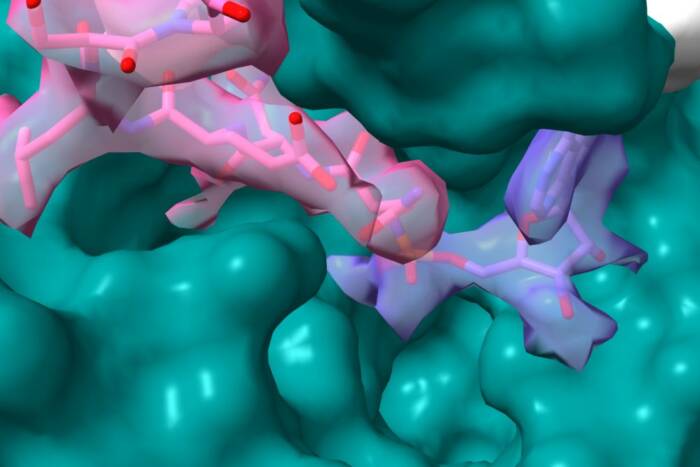'Geneless' enzyme is key to how bacteria intack
To infect, bacteria must first stick. Several proteins on their cell wall surface are there simply to attach themselves to the surrounding tissues of their hosts, such as the warm, moist, inviting ones at the back of your throat.
Now new research from Sung Lee and Vincent Fischetti in Rockefeller’s Fischetti Lab has identified an enzyme essential to these proteins’ stickiness, and the scientists say their discovery could lead to drugs that prevent some of our most dangerous bacteria from gaining a foothold.
In addition to a cell membrane, bacteria also have a cell wall made up of peptides linked to sugars, called peptidoglycans. Numerous proteins are attached on the outside of the cell wall, and the one thing most have in common is that when they are first made, the proteins have the same five amino acids at the attachment end, termed LPXTG. To attach the proteins to the cell wall, an enzyme, named sortase, cuts in this sequence, hooking the rest of the protein into the cell wall.
“Cell surface proteins are indispensable for disease-causing bacteria trying to establish successful colonization and infection of host tissue,” says Fischetti, who made the discovery along with Sung Lee, a senior research associate, by studying Staphylococcus aureus, the bacteria that is responsible for many hospital infections and is rapidly becoming resistant to existing antibiotics. “The surface proteins play a part not only in adhesion to host cells and invasion, but in the bacteria’s ability to evade the immune system.”
Lee and Fischetti first discovered an enzyme that also cleaved the LPXTG motif in streptococcal bacteria, which cause strep throat, in 2002, along with another colleague, Vijaykumar Pancholi. They also found a natural inhibitor that blocked the enzyme and showed that it could kill not only strep bacteria, but also staph and other disease bacteria. Now, Lee and Fischetti have purified the enzyme, called LPXTGase, from S. aureus, and show that the enzymes from the two bacteria are very similar in their irregularities.
Both enzymes are unique in that they are composed partly of unconventional amino acids and don’t have a corresponding gene. Genes, which serve as the cell’s recipes for creating proteins and enzymes, are typically linked directly to such enzymes. But a scan of the two bacteria’s genomes did not turn up any template that coded for LPXTGase, suggesting that the enzyme must be assembled by other enzymes within the bacteria. Based on the amino acids used, Fischetti and Lee suggest that the enzymes needed to construct the cell wall are also used to build the LPXTGase from scratch. Other small peptide antibiotics were known to be geneless, but the LPXTGase enzyme was the first large, complex protein found to be constructed this way.
Based on their findings, Fischetti and Lee think that drugs based on the natural inhibitor could be a new way to fight strep, staph and other infections; an antibiotic that blocked LPXTGase would not only prevent bacteria from attaching themselves to tissues from which they can launch an infection, but could kill them outright. The fact that it doesn’t have an associated gene is also an advantage for drugmakers. Without a genetic template, the bacteria would be slow to develop resistance to the new drugs.
Journal of Bacteriology 188(2): 389-398 (January 2006)(opens in new window)


